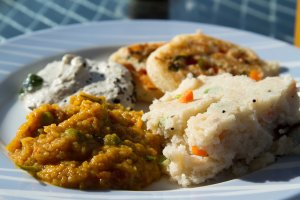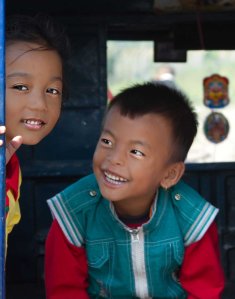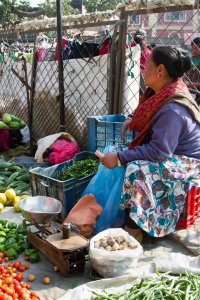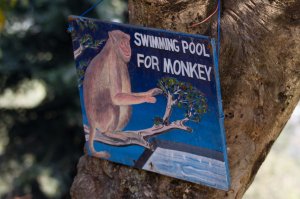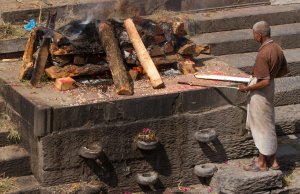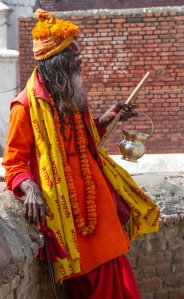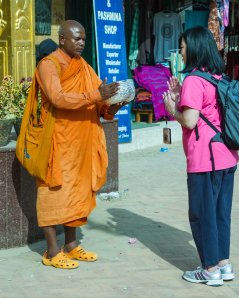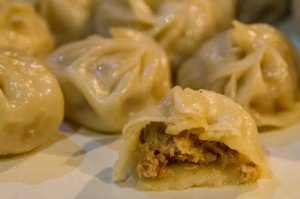I awoke at 4.30am this morning despite being dead tired the night before. Heard prayer bells as early as 5am. There must be a temple nearby. Hopefully, I am not too tired tomorrow – might just try getting out early.
We went to the coffee shop for breakfast and I was amazed with the variety of Nepalese and Western food on display. The idly with the coconut chutney was just simply out of this world. Already looking forward to tomorrow’s spread. I wonder if it’s the same.
This morning we headed out to the monkey temple as it is known by tourists (due to the number of monkeys there) or Swayambunath to the locals. A wee bit out of town towards the west of the city. We drive through some parts of the city which pretty much looks like a war zone minus the military. Pot holes were common, people drive on both sides of the road, which makes me wonder at times if we are on a one way street. You look out side the window of the van and you see buildings which looks like either it was half completed or half demolished, which I could never tell. Between all the rumbles, you see people living and you see smiles on faces of children.
We arrive at the foot of the temple (which is perched on a hill) and there is a huge market, so we decided to stop for photos. It was pretty much like any other Asian third world market. Mostly ladies selling fresh vegetables and the odd men selling miscellaneous stuff. What sets this market apart from the other markets I have seen is the weighing scale used by the traders. The women use real traditional ways of weighing the vegetables they sell. I haven’t seen those for a very long time. The other thing that caught my eye was ladies selling bright carnations. The flowers were sold to people who wish to make offerings to Buddha. Just as we were about to leave the market, we saw people selling live buffaloes and goats. According to the guide, the buffaloes go for about Rs.15,000 each which works out to be just over NZ$200 – for the whole buffalo! They don’t look very fat but it is still cheap.
We reach the top of he temple and there are more monkeys. There was a lady feeding them some distance away – which is a way of offering to the gods. If you counted all the monkeys present at temple, there would be more of them than us! The monkeys are worshipped to the extent that the locals even built a ‘monkey swimming pool’ as it is sign posted.
We walk to the top and were amazed at the views of the entire Kathmandu Valley. The only thing that spoils it is the fog or dust that just lingers over the valley, a result of four million people living in constant reconstruction of their city with poor environmental responsibility or awareness.
As we walk around the temples and stupas, we witness prayers, blessings of new born and offerings made by the local worshippers. While I was happily snapping away at people doing all this, I wondered how they felt. Trying to engage in a religious ceremony which is a private and solemn affair, while having hundreds of foreigners around trying to see what you do and photograph all that.
Although I am not strictly a Buddhist, the concept of religion is similar. So, I made an offering of a lighted candle.
Our next temple for the day was an opposite contrast to the earlier one. From a temple to worship the living, we make our way to the largest Hindu and Buddhist crematorium in Nepal, Baudha. We see various pyres by the river which only until now I saw on National Geographic or documentaries. There are at least three bodies being cremated at the time we are there. Depending on whether you were rich or had a status in life, you had a covered or open air cremation. The remains, mostly ashes, bones and the remaining wood is pushed into the river, once everything is done. The river flows from the Himalayas and joins the Ganges in India, further south. Aptly, you find shrines of Lord Shiva, the destroyer all around the crematorium.
At this place, there were many Sadhus happy to pose for a photo but once you took a shot, they demand money. Sadhus are Hindus “monks” who give up life’s worldly possessions for a simple life and live on the kindness of human beings. But some obviously see a lucrative proposition in all of this and take the opportunity to enrich themselves. Sometimes you wonder if they were big time fraudsters or just someone who had a change of heart some where along the path to enlightenment.
The last stop for the day is a Tibetan Buddhist monastery and the largest stupa in the world, called Pashupatinath. Before exploring the place, we stop for lunch at a roof top restaurant. All the restaurants there face the stupas and had pretty interesting names. One caught my eye ‘Heavenly Views’.
We go around the stupa which takes us at least 20 minutes. We also see monks (similar to the Sadhus, who give up the luxuries for a simple life) begging for alms. This time I give one monk some money and I was blessed by him. I know I have done something worthwhile and I know the blessing I received was genuine.
On our way back to the minivan, we see a few money changers with a difference. These ladies had piles of cold hard cash stacked in front of them and offered to change your large denomination notes to smaller ones so that you can make offerings in smaller amounts (you obviously couldn’t ask for change at the donation box or from a monk). As I collect banknotes and she had a few crisp small denominations, I asked if I could change a few. So, I picked up some small notes that I still had not yet collected which was worth about Rs. 40 in total. I ask if I could just exchange them. To my horror, she wants Rs. 200 for the Rs. 40. The worst exchange rate in the world, probably!
When we get back to the hotel, we got briefed on the next day’s trip to Chitwan National Park. And I needed a black or dark long sleeved top for some of the activities due to insects and mosquitoes. After the briefing we head out to Thamel on our own to look for a to.
We pass by a shop that was selling an impressive looking chess set with its pieces carved to look like Nepali kings and their subjects. I enquired what it might cost and am quoted US$270 for a set. Way beyond what I could afford. We wonder around Thamel for awhile, get a long sleeved shirt for an incredible NZ$5 and also some other souvenirs.
For dinner we go to a popular place near the hotel, called Nanglo. It seems popular as there were many groups and was pretty crowded. I order a Nepali Thali which was a rice set meal with an assortment of curries and condiments. We also order some Momos and some barbequed Paneer (Indian cottage cheese). Vera ordered grill fish with rice. The rice is not the plain rice we thought but was fried rice with spices and vegetables. As with all meals here, we were set back by a whopping Rs.1400 or NZ$20.

